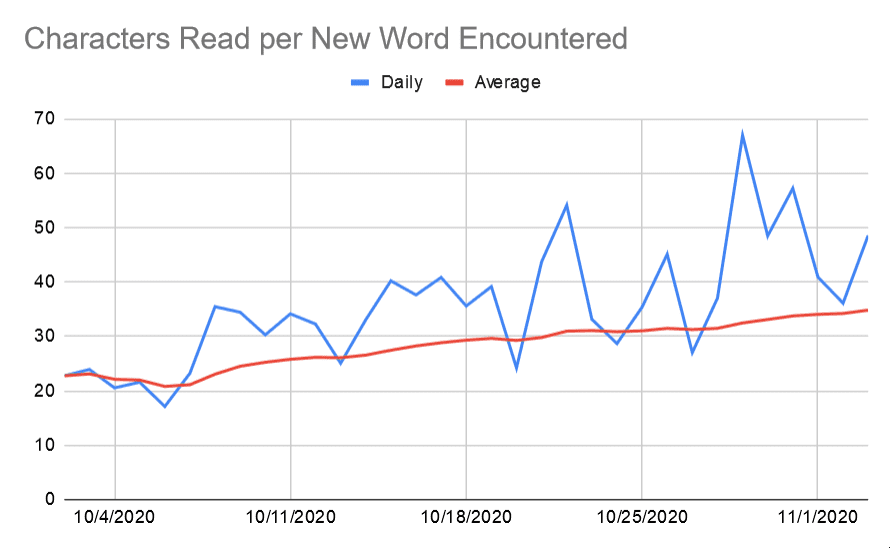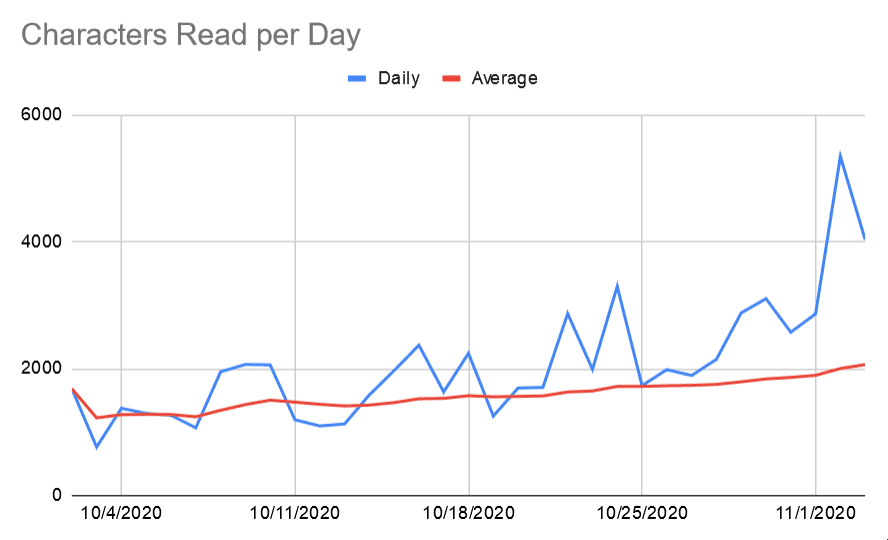「コンビニ人間」, or it’s English translation, Convenience Store Woman, is an award-winning book about an outcast trying to fit into society. I don’t remember where I first heard about this book, but I saw that a few people in the Japanese language learning community have read it during their studies. Since extensive reading has been shown to be one of the best ways to acquire a language, I decided to give it a go.
The Method
I decided to do a brute force approach to reading. Armed with the browser extension Yomichan, it’s not too time consuming to look up new words, so that’s what I did. I looked up every since word that I encountered that I didn’t know so that I could follow along with the story. Here’s what I didn’t do: I didn’t try to memorize the words I looked up. Sometimes I’d listen to the pronunciation and try to repeat it, but I didn’t spend any effort memorizing words on the spot. My goal while reading is to enjoy the story, not conciously learn vocabulary. Again, this is the different between learning a language and acquiring a language. Other than that, I just read as much as I wanted for the day, but also wanted to finish the book within a month if possible.
The Execution
I highlighted every word I didn’t recognize, and then once I’m done reading for the day, I went back and made i+1 and i+2 sentence cards. Along with this, I kept count of how many words I highlighted, how many words I saved, and also how many words I read every day. This way, I could put all that data into Excel and see any patterns that emerged.
The Book Difficulty Review For Japanese Learners
As a reference, according to MorphMan I had around 3000 words in my passive vocabulary and around N3 level grammar knowledge when I first started reading.
You know, for a book with the words Convenience Store in its name, I was expecting to learn more conversationally useful vocab from it. I was expecting sentences like “can I get that item on the top shelf”, but instead I got sentences like “humans are just gears rotating in the system that is society”. Not that I’m really complaining, but the book was way more depressing than I thought it’d be.
In terms of difficulty for Japanese learners, it wasn’t that bad overall. I knew most of the grammar, picked up a few N2 grammar points, and even an N1 grammar point. I knew that I was missing some more advance grammar though because there were some sentences where even though I knew all the words, it didn’t make sense to me. That didn’t really matter though since I still got the gist of what was happening, so I didn’t let it worry me. Once I read more books, I’m sure that I can go back and understand everything.
The only thing that I’d warn about for new Japanese readers is that books frequently use this grammar point called 「体言止め」which is really off-putting at first since it defies the universal grammar rule that all Japanese sentences end in a verb. If you’re used to the normal flow of a Japanese sentence, you’ll probably get tripped up when encountering it.
The Results
In total, I encountered 1956 words I didn’t recognize, and through them made flash cards for 443 words. Since I recorded the number of unknown words I encountered as well as the number of character I’ve read on a given day, I could plot a graph that shows on average how many characters I could read before encountering an unknown word. Now, this data isn’t perfect since a word like「たべさせられます」would count for 1 word but 7 characters, but it gives an overall trend in reading comprehension that I think is interesting and also valuable in maintaining motivation. I started out encountering a new word every 20 characters, and I got it up to every 35 characters before the book finished.
The Conclusion
Here’s what I re-learned from doing this: reading is a skill that you have to train. Just because you know what all the words on a page mean doesn’t mean that you can read that page. If you ever tried to read a research paper in your native language but can’t get through the intro paragraph, that’s not because you don’t know the words. It’s because you haven’t trained your reading ability to handle the heightened word difficulty level and your brain has to strain itself more to parse each sentence (or you have ADHD, in which case I apologize). A similar feeling happens when starting to read in any language. At the beginning, I was struggling to read even a single page, and only clocked in 1000 characters a day, but by the end of the month that number started to increase noticeably.
Also another thing to note: each book and author has their own set of unique vocabulary that they like to use. Just because a word appears many times in one book doesn’t mean it’s actually used that frequently in the wild. It might just be the author’s personal preference. You have to pick your battles when learning new words and try to balance it between word frequency and relative importance to the book in question.
I’m definitely going to continue reading; the only issue is finding interesting books to read. This endeavor is part of my ‘100 days of extensive immersion without using subs2srs and MorphMan’ challenge, so the actual conclusions will be done in a writeup for that once I finish the challenge in December.


